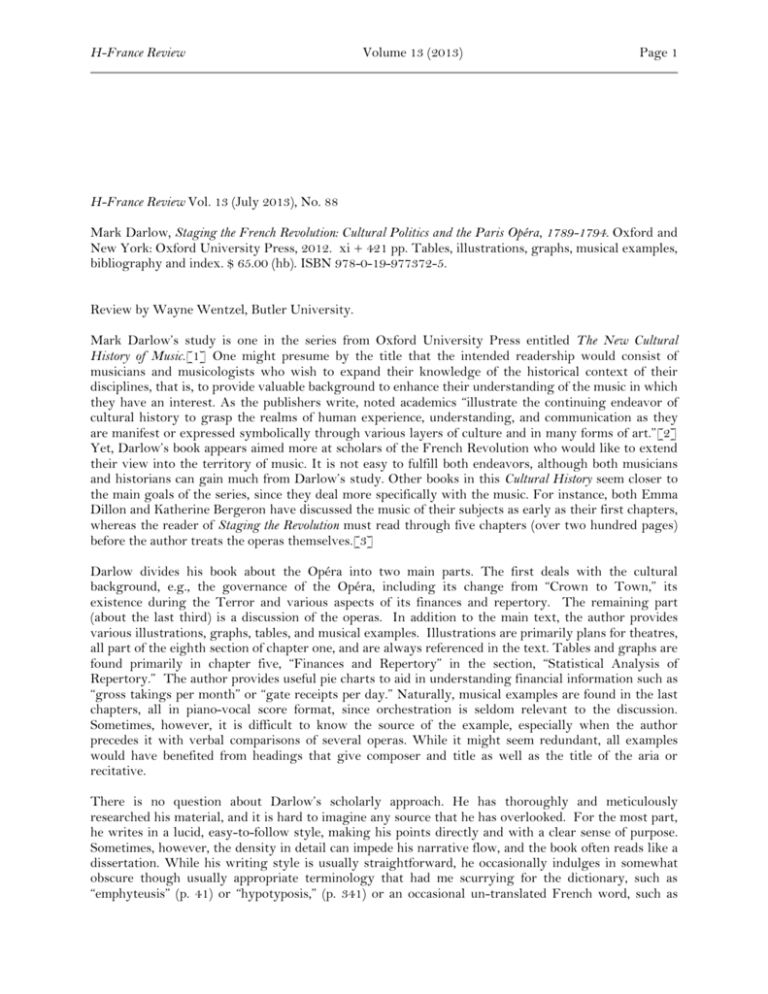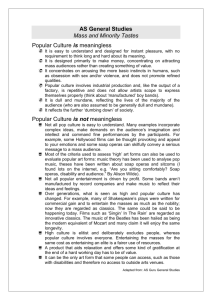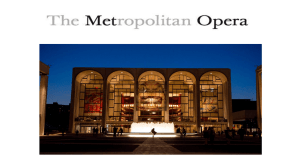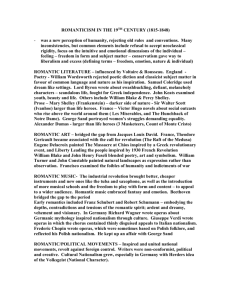
H-France Review
Volume 13 (2013)
Page 1
H-France Review Vol. 13 (July 2013), No. 88
Mark Darlow, Staging the French Revolution: Cultural Politics and the Paris Opéra, 1789-1794. Oxford and
New York: Oxford University Press, 2012. xi + 421 pp. Tables, illustrations, graphs, musical examples,
bibliography and index. $ 65.00 (hb). ISBN 978-0-19-977372-5.
Review by Wayne Wentzel, Butler University.
Mark Darlow’s study is one in the series from Oxford University Press entitled The New Cultural
History of Music.[1] One might presume by the title that the intended readership would consist of
musicians and musicologists who wish to expand their knowledge of the historical context of their
disciplines, that is, to provide valuable background to enhance their understanding of the music in which
they have an interest. As the publishers write, noted academics “illustrate the continuing endeavor of
cultural history to grasp the realms of human experience, understanding, and communication as they
are manifest or expressed symbolically through various layers of culture and in many forms of art.”[2]
Yet, Darlow’s book appears aimed more at scholars of the French Revolution who would like to extend
their view into the territory of music. It is not easy to fulfill both endeavors, although both musicians
and historians can gain much from Darlow’s study. Other books in this Cultural History seem closer to
the main goals of the series, since they deal more specifically with the music. For instance, both Emma
Dillon and Katherine Bergeron have discussed the music of their subjects as early as their first chapters,
whereas the reader of Staging the Revolution must read through five chapters (over two hundred pages)
before the author treats the operas themselves.[3]
Darlow divides his book about the Opéra into two main parts. The first deals with the cultural
background, e.g., the governance of the Opéra, including its change from “Crown to Town,” its
existence during the Terror and various aspects of its finances and repertory. The remaining part
(about the last third) is a discussion of the operas. In addition to the main text, the author provides
various illustrations, graphs, tables, and musical examples. Illustrations are primarily plans for theatres,
all part of the eighth section of chapter one, and are always referenced in the text. Tables and graphs are
found primarily in chapter five, “Finances and Repertory” in the section, “Statistical Analysis of
Repertory.” The author provides useful pie charts to aid in understanding financial information such as
“gross takings per month” or “gate receipts per day.” Naturally, musical examples are found in the last
chapters, all in piano-vocal score format, since orchestration is seldom relevant to the discussion.
Sometimes, however, it is difficult to know the source of the example, especially when the author
precedes it with verbal comparisons of several operas. While it might seem redundant, all examples
would have benefited from headings that give composer and title as well as the title of the aria or
recitative.
There is no question about Darlow’s scholarly approach. He has thoroughly and meticulously
researched his material, and it is hard to imagine any source that he has overlooked. For the most part,
he writes in a lucid, easy-to-follow style, making his points directly and with a clear sense of purpose.
Sometimes, however, the density in detail can impede his narrative flow, and the book often reads like a
dissertation. While his writing style is usually straightforward, he occasionally indulges in somewhat
obscure though usually appropriate terminology that had me scurrying for the dictionary, such as
“emphyteusis” (p. 41) or “hypotyposis,” (p. 341) or an occasional un-translated French word, such as
H-France Review
Volume 13 (2013)
Page 2
“bienséance”(p. 245) or “didascales”(p. 374). Some of his expressions are clever, e.g. a “pseudo-Gluckian
sobriety” (p. 233) (many musicians would exactly understand that analogy), but others seem overly so,
such as “politically anodyne” (p. 274) or “a rich quantity of peripitea.” (p. 234.)
In the last chapters devoted specifically to the operas, the author seeks to introduce readers to a
repertoire largely unknown to traditional opera enthusiasts and scarcely known even to the most
stalwart music scholars. A few composers’ names are familiar to anyone who has had basic music history
courses, such as François Josef Gossec, Etienne-Nicolas Mehul and André Gretry, but the particular
operas that the author discusses go well beyond their most recognizable compositions. His selections
logically relate more to Revolutionary times than those in the standard repertoire. Most intriguing,
however, are the discussions of operas by composers who are hardly household names, such as Jean
Baptiste Lemoyne, Louis Jadin, and Johann Christoph Vogel. Their works are a true revelation of an
important but neglected period in French music history.
The author’s organization in this section is clear and his categories logical: first “Tragedy and [other]
Serious Works,” then “Comic and Mixed Works,” concluding with the “Republican Repertory,” the part
that most closely relates to the title of the book. Darlow lists the operas under consideration near the
beginning of each chapter, and then singles out several for discussion. Some operas, while extolling the
virtue of liberty, still retain a respect for the monarchy, but that reflects the early stage of the
Revolution during the Constitutional Monarchy when Revolutionary ideals and a monarchical state
were still idealistically compatible. After the king’s execution and before the Terror, operas emphasized
the new sense of liberty implied by the Republic. A few Republican operas even reflected the new times
by rejecting Old Regime genre titles such as “tragédie lyrique” but instead inventing new ones such as
“tableau patriotique” (Lemoyne and Reigny’s Toute La Grèce) and “Sans-culottide dramatique” (Porta and
Bocquier/Moline’s Réunion du 10 Août).
In emphasizing the relationship of operas to the particular period of the Revolution, Darlow naturally
dwells more on the text than the music. He often provides texts of arias or recitatives to illustrate his
main points, always in both the original French and lucid English translations. He does not, however,
include many musical examples, and sometimes his choices seem rather arbitrary. Many times, after a
particularly interesting comment, I would have liked to see how the text and music illustrated his
viewpoint.
Of particular interest to many readers are the operas whose librettos dealt specifically with events of the
Revolution itself, such as Louis Jadin’s Le Siège de Thionville. Its libretto by Saulnier and Dutilh
contained actual historical figures. Another focus of interest is the incorporation of Revolutionary songs
into an opera. While the author mentions several instances, it would have been good to see the way the
librettist and composer brought about such inclusions. Were they just sung as rousing choruses, or
were they fused into the dramatic situation, as they were in much later operas, such as Umberto
Giordano’s Andrea Chénier (1896), and Jean Nouguès’s L’Aigle (1912)? It would have been good to see a
particular instance presented in a musical example.
After Darlow’s discussions, readers are likely to become interested in seeing more of the scores beyond
these brief musical examples. Unfortunately, finding such scores will prove frustrating. The most
readily available source for opera scores of this period is the “Petrucci” website, IMSLP (International
Music Score Library), which contains over 200,000 published scores and manuscripts. Unfortunately,
few scores discussed in the book are available at this site. One of the few is Gossec’s Le triomphe de la
République, a good example of French Revolutionary opera. Only a handful of scores are available at
various libraries around the United States, including the Newberry Library in Chicago and the music
libraries at Harvard University and Duke University.[4]
H-France Review
Volume 13 (2013)
Page 3
One of the most unusual and potentially controversial aspects of this publication is one that may become
more commonplace in this age of computers and easily available web-sources. The book is designed
primarily for readers of English, but the main sources are in French. To include both the original
French quotations and English translations either within the text or as footnotes or endnotes would
needlessly clutter the text and make the book longer and more expensive. Therefore, the author
includes only his well thought-out translations for long citations, and refers readers to a specifically
designed “Companion Website” at Oxford University Press for the original French.[5] One slight
drawback to this innovation lies in the format. While the quotations are all given in the order in which
they are cited, chapter by chapter, neither page numbers nor footnote numbers from the book are
included. Consequently, it can take some time to match the quotation with the translation in the text.
In addition to the French quotations, this website contains a brief biography of the author, some general
information about the book, and a “Chronology of Revolutionary Events,” a useful checklist with which
the history of the Opéra can be coordinated. The Companion also contains a short list of the various
names given to the Opéra over the Revolutionary time period. Perhaps most important is a list of the
sources of the operas that the author discusses in the book itself. They are arranged alphabetically by
title, but neither the names of librettists nor the composers are included. Of course such information is
already present in the text, but the addition of both items in this list would have been helpful, and would
not have taken up much space. Moreover, readers will need to familiarize themselves with various
abbreviations given at the end of the list.
In general, Staging the Revolution is a valuable resource for many French operas that have fallen out of
favor since the period of the Revolution. While it may be better considered as a reference tool than a
good read, Darlow’s study nevertheless fulfills an important need in an area long neglected by music
scholars.
NOTES
[1] Mark Darlow studied at the University of Kent (Canterbury) and at the Ecole normale supérieure
(Paris). He was Lecturer at the University of Nottingham and is currently Senior Lecturer in French at
the University of Cambridge.
[2] Jane F. Fulcher is the general editor of this series. She sets out this premise in the abstract for the
initial book, The Oxford Handbook of the New Cultural History of Music, New York and Oxford, 2011. The
abstract is provided on the website:
http://www.oxfordhandbooks.com/view/10.1093/oxfordhb/9780195341867.001
[3] Emma Dillon, Sense of Sound: Musical Meaning in France, 1260-1330 (London: Oxford University
Press, 2012) and Katherine Bergeron, Voice Lessons: French Mélodie in the Belle Epoque (London: Oxford
University Press, 2010)
[4] As one might expect, there are few recordings. Based on searches at Amazon.com and the
ArkivMusic websites, only three recordings of any of these operas are available: Gossec’s Le Triomphe de
la République, conducted by Diego Fasolis (Chandos 707, 100557), Gretry’s La Caravane de Caire, Marc
Minkowski (Ricercar 100084) and Salieri’s Tarare, Jean-Claude Malgoire (Arthaus 100557). A
videorecording of the latter from a 1988 production at the Schwetzinger Festspiel is also available on
DVD from Arthaus. Because the Gossec and Salieri scores are available at the Petrucci site, one could
listen to the recordings while following the music.
[5] www.oup.com/us/stagingthefrenchrevolution
H-France Review
Volume 13 (2013)
Page 4
Wayne Wentzel
Butler University
wwentzel@butler.edu
Copyright © 2013 by the Society for French Historical Studies, all rights reserved. The Society for
French Historical Studies permits the electronic distribution of individual reviews for nonprofit
educational purposes, provided that full and accurate credit is given to the author, the date of
publication, and the location of the review on the H-France website. The Society for French Historical
Studies reserves the right to withdraw the license for edistribution/republication of individual reviews
at any time and for any specific case. Neither bulk redistribution/ republication in electronic form of
more than five percent of the contents of H-France Review nor re-publication of any amount in print
form will be permitted without permission. For any other proposed uses, contact the Editor-in-Chief of
H-France. The views posted on H-France Review are not necessarily the views of the Society for
French Historical Studies.
ISSN 1553-9172








